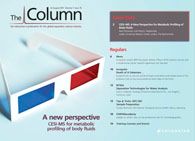Collaborative cancer research agreement
The National Cancer Center, situated in Chuo-ku, Tokyo, Japan, and Shimadzu have reached a comprehensive collaborative research agreement that, it is hoped, will lead to the development of internationally leading, high-level, cutting-edge medical technologies that contribute to the suppression of cancer and the promotion of human health.

The National Cancer Center, situated in Chuo-ku, Tokyo, Japan, and Shimadzu have reached a comprehensive collaborative research agreement that, it is hoped, will lead to the development of internationally leading, high-level, cutting-edge medical technologies that contribute to the suppression of cancer and the promotion of human health. These include technological developments related to the realization of ultra-early cancer diagnoses, pharmacokinetic analysis for the achievement of a revolution in the drug discovery process, and medical treatments. According to the company, these developments will be accomplished through a fusion of the high-level cancer research techniques and clinical experience at the centre, and the company’s technologies in next-generation medical treatment fields.
The company has been pursuing R&D in the medical treatment fields of molecular imaging technology and biomarker searches, based on the fusion and application of its chromatography, mass spectrometry and other core analysis and measuring technology with medical imaging technology.
“Thus far,” said the company’s president Akira Nakamoto, ”the life sciences have been the core enterprise at Shimadzu. In the future, however, I would like to see the biomarker candidates discovered to‑date applied to ultra-early diagnosis; we believe this can be accomplished through the implementation of clinically useful medical science and a fusion of imaging diagnostics and molecular imaging, in conjunction with the NCC.”
For more information on the company visit www.shimadzu.com
This story originally appeared in The Column. Click here to view that issue.
Best of the Week: Food Analysis, Chemical Migration in Plastic Bottles, STEM Researcher of the Year
December 20th 2024Top articles published this week include the launch of our “From Lab to Table” content series, a Q&A interview about using liquid chromatography–high-resolution mass spectrometry (LC–HRMS) to assess chemical hazards in plastic bottles, and a piece recognizing Brett Paull for being named Tasmanian STEM Researcher of the Year.
Using LC-MS/MS to Measure Testosterone in Dried Blood Spots
December 19th 2024Testosterone measurements are typically performed using serum or plasma, but this presents several logistical challenges, especially for sample collection, storage, and transport. In a recently published article, Yehudah Gruenstein of the University of Miami explored key insights gained from dried blood spot assay validation for testosterone measurement.
Determination of Pharmaceuticals by Capillary HPLC-MS/MS (Dec 2024)
December 19th 2024This application note demonstrates the use of a compact portable capillary liquid chromatograph, the Axcend Focus LC, coupled to an Agilent Ultivo triple quadrupole mass spectrometer for quantitative analysis of pharmaceutical drugs in model aqueous samples.
